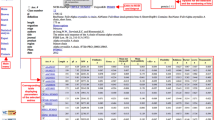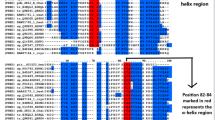Abstract
Small heat shock proteins (sHSPs), as one subclass of molecular chaperones, are important for cells to protect proteins under stress conditions. Unlike the large HSPs (represented by Hsp60 and Hsp70), sHSPs are highly divergent in both primary sequences and oligomeric status, with their evolutionary relationships being unresolved. Here the phylogenetic analysis of a representative 51 sHSPs (covering the six subfamilies: bacterial class A, bacterial class B, archae, fungi, plant, and animal) reveals a close relationship between bacterial class A and animal sHSPs which form an outgroup. Accumulating data indicate that the oligomers from bacterial class A and animal sHSPs appear to exhibit polydispersity, while those from the rest exhibit monodispersity. Together, the close evolutionary relationship and the similarity in oligomeric polydispersity between bacterial class A and animal sHSPs not only suggest a potential evolutionary origin of the latter from the former, but also imply that their oligomeric polydispersity is somehow a property determined by their primary sequences.




Similar content being viewed by others
References
Anfinsen CB (1973) Principles that govern the folding of protein chains. Science 181:223–230
Bova MP, Ding LL, Horwitz J, Fung BK-K (1997) Subunit Exchange of alpha-crystallin. J Biol Chem 272:29511–29517
Bova MP, Mchaourab HS, Han Y, Fung BK-K (2000) Subunit exchange of small heat shock proteins. J Biol Chem 275:1035–1042
Bova MP, Huang Q, Ding L, Horwitz J (2002) Subunit exchange, conformational stability, and chaperone-like function of the small heat shock protein 165 from Methanococcus jannaschii. J Biol Chem 277:38468–38475
Brocchieri L, Karlin S (2000) Conservation among Hsp60 sequences in relation to structure, function and evolution. Protein Sci 9:476–486
Bruno WJ, Socci ND, Halpern AL (2000) Weighted neighbor joining: a likelihood-based approach to distance-based phylogeny reconstruction. Mol Biol Evol 17:189–197
Bukau B, Horwich AL (1998) The Hsp70 and Hsp60 chaperone machines Cell 92:351–366
Chang Z, Primm TP, Jakana J, Lee IH, Serysheva I, Chiu W, Gilbert HF, Quiocho FA (1996) Mycobacterium tuberculosis 16-kDa antigen (Hsp163) functions as oligomeric structure in vitro to suppress thermal aggregation J Biol Chem 271:7218-7224
Datta SA, Rao CM (2000) Packing-induced conformational and functional changes in the subunits of alpha-crystallin. J Biol Chem 275:41004–41010
de Jong WW Leunissen JAM Voorter CEM (1993) Evolution of the a-crystallin/small heat-shock potein family Mol Biol Evol 10(1):103–126
de Jong WW, Caspers GJ, Leunissen JA (1998) Genealogy of the alpha-crystallin—small heat-shock protein superfamily Int J Biol Macromol 22:151–162
Dobson CM, Karplus M (1999) The fundamentals of protein folding: bringing together theory and experiment. Curr Opin Struct Biol 9:92–101
Ehrnsperger M, Graber S, Gaestel M, Buchner J (1997) Binding of non-native protein to Hsp25 during heat shock creates a reservoir of folding intermediates for reactivation. EMBO J 16:221–229
Ehrnsperger M, Lilie H, Gaestel M, Buchner J (1999) The dynamics of Hsp25 quaternary structure. J Biol Chem 274:14867–14874
Felsenstein J (1985) Confidence limits on phylogenies: an approach using the bootstrap Evolution 39:783–791
Felsenstein J, Churchill GA (1996) A hidden Markov model approach to variation among sites in rate of evolution Mol Biol Evol 13(1):93–104
Fu X, Li W, Mao Q, Chang Z (2003) Disulfide bonds convert small heat shock protein Hsp163 from a chaperone to a non-chaperone: implications for the evolution of cysteine in molecular chaperones. Biochem Biophys Res Commun 308:627–635
Gu L, Abulimiti A, Li W, Chang Z (2003) Monodisperse Hsp163 nonamer exhibits dynamic dissociation and reassociation, with the nonamer dissociation prerequisite for chaperone-like activity. J Mol Biol 319:517–526
Gupta RS (1995) Phylogenetic analysis of the 90 kD heat shock family of protein sequences and an examination of the relationship among animals, plants, and fungi species. Mol Biol Evol 12:1063–1073
Gupta RS, Golding B (1993) Evolution of Hsp70 gene and its implications regarding relationships between archaebacteria, eubacteria, and eukyrotes. J Mol Evol 37:573–582
Haley DA, Horwitz J, Stewart PL (1998) The small heat-shock protein, alphab-crystallin, has a variable quaternary structure. J Mol Biol 277:27–35
Haley DA, Bova MP, Huang QL, Mchaourab HS, Stewart PL (2000) Small heat-shock protein structures reveal a continuum from symmetric to variable assemblies. J Mol Biol 298:261–272
Hartl FU, Hayer-Hartl M (2002) Molecular chaperones in the cytocol: from nascent chain to folded protein Science 295:1852–1858
Haslbeck M, Walke S, Stromer T, Ehrnsperger M, White H, Chen S, Raibil H, Buchner J (1999) Hsp26: a temperature-regulated chaperone. EMBO J 18:6744–6751
Haslbeck M, Braun N, Stromer T, Richter B, Model N, Weinkauf S, Buchner J (2004a) Hsp42 is the general small heat shock protein in the cytosol of Saccharomyces cerevisiae. EMBO J 23:638–649
Haslbeck M, Ignatiou A, Saibil H, Helmich S, Frenzl E, Stromer T, Buchner J (2004b) A domain in the N-terminal part of Hsp26 is essential for chaperone function and oligomerization. J Mol Biol 343:445–455
Kappe G, Leunissen JA, de Jong W W (2000) Evolution and diversity of prokaryotic small heat shock proteins. Prog Mol Subcell Biol 28:1–17
Kim KK, Kim R, Kim SH (1998a) Crystal structure of a small heat-shock protein. Nature 394:595–599
Kim KK, Yokota H, Kim S-H (1998b) Purification, crystallization and preliminary X-ray crystallographic analysis of small heat shock protein homolog from Methanococcus jannaschii. J Struct Biol 121:76–80
Lee GJ, Pokala N, Vierling E (1995) Structure and in vitro molecular chaperone activity of cytosolic small heat shock proteins from pea. J Biol Chem 270:10432–10438
Lee GJ, Roseman AM, Saibil HR, Vierling E (1997) A small heat shock protein stably binds heat-denatured model substrates and can maintain a substrate in a folding-competent state. EMBO J 16:659–671
Leroux MR, Melki R, Gordon B, Batelier G, Candido EPMJ (1997) Structure-function studies on small heat shock protein oligomeric assembly and interaction with unfolded polypeptides. J Biol Chem 272:24646–24656
Lindquist S, Craig EA (1988) The heat-shock proteins Annu Rev Genet 22:631–677
Munchbach M, Nocker A, Narberhaus F (1999) Multiple small heat shock proteins in Rhizobia. J Bacteriol 181:83–90
Narberhaus F (2002) Alpha-crystallin-type heat shock proteins: socializing minichaperones in the context of a multichaperone network. Microbiol Mol Biol Rev 66(1):64–93
Nikoh N, Hayase N, Iwabe N, Kuma K, Miyata T (1994) Phylogenetic relationship of the kingdoms animalia, plantae and fungi, inferred from 23 different protein sequences. Mol Biol Evol 11:762–768
Plesofsky-Vig N, Vig J, Brambl R (1992) Phylogeny of the alpha-crystallin-related heat-shock proteins. J Mol Evol 35:537–545
Saitou N, Nei M (1987) The neighbor-jointing method: a new method for reconstructing phylogenetic trees. Mol Biol Evol 4:406–425
Schagger H, von Jagow G (1991) Blue native electrophoresis for isolation of membrane protein complexes in enzymatically active form. Anal Biochem 199:223–231
Shearstone JR, Baneyx F (1999) Biochemical characterization of the small heat shock protein IbpB from Escherichia coli. J Biol Chem 274:9937–9945
Sobott F, Benesch JLP, Vierling E, Robinson CV (2002) Subunit exchange of multimeric protein complexes. J Biol Chem 277:38921–38929
Studer S, Narberhaus F (2000) Chaperone activity and homo- and hetero-oligomer formation of bacterial small heat shock proteins. J Biol Chem 275:37212–37218
Studer S, Obrist M Lentze N, Narberhous F (2002) A critical motif for oligomerization and chaperone activity of bacterial a-heat shock proteins. Eur J Biochem 269:3578–3586
Sun Y, Mansour M, Crack JA, Gass GL, MacRae TH (2004) Oligomerization, chaperone activity, and nuclear localization of p26, a small heat shock protein from Artemia franciscana. J Biol Chem 279:39999–40006
Suzuki TC, Krawitz DC, Vierling E (1998) The chloroplast small heat-shock protein oligomer is not phosphorylated and does not dissociate during heat stress in vivo. Plant Physiol 116:1151–1161
Thompson JD, Higgins DG, Gibson TJ: CLUSTAL W: improving the sensitivity of progressive multiple sequence alignment through sequence weighting, positions-specific gap penalties and weight matrix choice. Nucleic Acids Res 22:4673–4680
van de Klundert FA, Smulders RH, Gijsen ML, Lindner RA, Jaenicke R, Carver JA, de Jong WW (1998) The mammalian small heat-shock protein Hsp20 forms dimers and is a poor chaperone. Eur J Biochem 258:1014–1021
Vanhoudt J, Abgar S, Alerts T, Clauwaert J (2000) Native quaternary structure of bovine alpha-crystallin. Biochemistry 39:4483–4492
van Montfort RLM, Basha E, Fieldrich KL, Viering E (2001) Crystal structure and assembly of a eukaryotic small heat shock protein. Nature Struct Biol 8:1025–1030
Veigner L, Diamant S, Buchner J, Goloubinoff P (1998) The small heat-shock protein IbpB from Escherichia coli stabilizes stress-denatured proteins for subsequent refolding by a multichaperone network. J Biol Chem 273:11032–11037
Vierling E (1991) The roles of heat shock response in plants. Annu Rev Plant Physiol Plant Mol Biol 42:579–620
Waters ER (1995) The molecular evolution of the small heat-shock proteins in plants. Genetics 141:785–795
Waters ER, Vierling E (1999) The diversion of plant cytosolic small heat shock proteins preceded the divergence of mosses. Mol Biol Evol 16:127–139
Waters ER, Lee G, Vierling E (1996) Evolution, structure and function of the small heat shock proteins in plants. J Exp Bot 47:325–338
Acknowledgments
This work was funded by the National Key Basic Research Foundation of China (Grant G1999075607) and the National Natural Science Foundation of China (Grant 30270289). The authors wish to thank Dr. Bernard K. K. Fung (Jules Stein Eye Institute, University of California, School of Medicine, Los Angeles) for his kind gift of vector pET20b+ carrying the cDNA gene of rat αA-crystallin, Dr. Sung-Hou Kim (Physical Biosciences Division of the Lawrence Berkeley National Laboratory and Department of Chemistry, University of California at Berkeley) for his kind gift of vector pET21a carrying the gene of M. jannaschii Hsp16.5, and Dr. Elizabeth Vierling (Department of Biochemistry and Molecular Biophysics, University of Arizona, Tucson) for his kind gift of vector PJC20 carrying the gene of wheat Hsp16.9. The authors are also grateful for the enlightening discussions and help provided by members of Dr. Chang’s laboratory (especially Mr. Zhang Xuefeng).
Author information
Authors and Affiliations
Corresponding author
Additional information
[Reviewing Editor: Dr. Martin Kreitman]
Rights and permissions
About this article
Cite this article
Fu, X., Jiao, W. & Chang, Z. Phylogenetic and Biochemical Studies Reveal a Potential Evolutionary Origin of Small Heat Shock Proteins of Animals from Bacterial Class A. J Mol Evol 62, 257–266 (2006). https://doi.org/10.1007/s00239-005-0076-5
Received:
Accepted:
Published:
Issue Date:
DOI: https://doi.org/10.1007/s00239-005-0076-5




